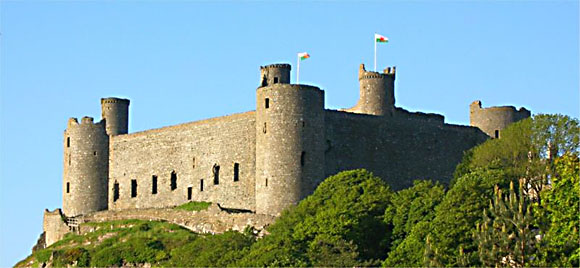Harlech Castle, located in Harlech, Wales, is a Concentric castle, constructed atop a cliff close to the sea (which has since receded). It is particularly notable for its massive gatehouse.
Construction
Begun in 1283 as part of Edward I's second Welsh campaign, the castle was part of Edward's "iron ring" of castles around coastal Snowdonia. Like many of the castles in the area, Harlech was designed by Master James of St. George. The castle took seven years to build, and cost an estimated �8190 to build (Taylor, 1029). Following its completion, James was appointed Constable of Harlech Castle, a position he held for over three years.
The castle is built to a concentric plan, with one line of defences enclosed by another. The outer walls are much shorter and thinner than the mighty inner walls, and have no towers defending them besides the small gatehouse. The inner ward is roughly square, with a large round tower at each corner. The domestic buildings, including the great hall, are built against the inside of the inner walls. Since the surrounding cliffs made it practically impossible to attack the castle except from the east, this side is faced by the imposing gatehouse. The gate is flanked by two massive "D-shaped" towers, the standard plan of the era, and defended by a series of doors, portcullises and murder-holes. Noteably, there are large windows on the inner face of the gatehouse, showing it's second role as the premier domestic accommodation. The west wall of the inner ward also has large windows (as it forms one wall of the great hall), which would make it vulnerable were it not for the aforementioned cliffs.
Harlech is also notable for an unusual feature: the "way from the sea". Edward's forces were often in danger from land-based attack, but he enjoyed total supremacy on water. Many of his castles included "sally ports" which allowed resupply from the sea, but Harlech's is far more elaborate. Here, a fortified stairway hugs the rock and runs almost 200 feet down to the foot of the cliffs, where (at the time of construction) the sea reached. Today, the sea has retreated several miles, making it more difficult to envisage the concept in its original setting. James of St. George's plan was a triumph; when the castle was besieged during Madoc ap Llywelyn's campaign (see below), this stairway was used to supply the castle.
Like many of Edward's castles, Harlech was originally designed to work in tandem with city walls.
History
In 1294, Madoc ap Llywelyn, cousin to Llywelyn ap Gruffydd, began an uprising against English rule that spread quickly through Wales. Several English-held towns were razed and Harlech (along with Criccieth Castle and Aberystwyth Castle) were besieged that winter. As noted above, the "Way to the Sea" helped the defenders survive until the siege was lifted the following spring.
In 1404, the castle fell to Owain Glyndŵr, becoming his residence and headquarters. Four years later, after another long siege, Harlech Castle was retaken by Prince Henry (later Henry V), and Glyndŵr's wife and two of his daughters were captured.
In the Wars of the Roses Harlech was held by Sir Richard Tunstall as a Lancastrian stronghold in the first part of Edward IV of England's reign (1461-1470). It was the last Lancastrian fortress to surrender when it did so in 1468; it was able to withstand the seven-year siege through its being provisioned from the sea. This siege partially inspired the song "Men of Harlech".
During the English Civil War the castle was the last royalist fortress to hold out against the Parliamentary forces. The surrender, on the 16th of March, 1647, long after King Charles had himself been captured, marked the end of the first phase of the war.
Present day
Harlech is part of the "Castles and Town Walls of King Edward in Harlech, Beaumaris, Caernarfon and Conwy (Gwynedd)" World Heritage site, reflecting its importance and remarkable state of preservation.
The castle is now in the care of Cadw and is open to visitors. |
















